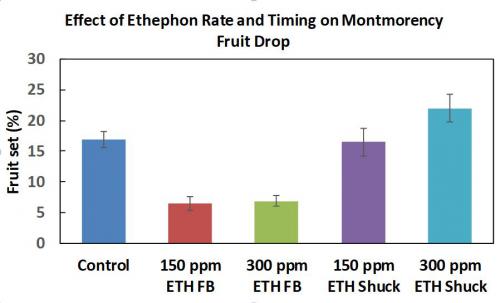How to manage brine cherries that will not be harvested in 2018
Preliminary data suggest ethephon may be a tool to remove unwanted sweet cherries.
Some growers have been informed that their light-colored sweet cherries intended for the brine market are not needed during the 2018 season. This news is certainly unfortunate, but because light sweets are often interplanted with dark sweet cherries, this situation is even more complicated. Growers that do not plan to harvest light sweets are wondering if there is a method to remove fruit from the trees—removing fruit will minimize American brown rot infections as well as spotted wing Drosophila (SWD) infestations, both of which can easily spread to adjacent dark sweets.
Growers have inquired about using lime sulfur and oil or ammonium thiosulfate fertilizer to burn off the blossoms in the light sweets. Lime sulfur and oil will remove blossoms by burning the stigma and pistils, and this material prevents pollen germination and fertilization. Lime sulfur and oil additionally depresses photosynthetic activity of the tree for a few days post-application. Ammonium thiosulfate fertilizer has been used in apples to remove blossoms solely as a caustic thinner. However, neither of these options is ideal as most growers are likely depending on the light sweet blossoms for pollination of the dark sweet cherries.
If lime sulfur and oil or ammonium thiosulfate fertilizer are used to burn off the blossoms, these flowers will likely be non-viable as pollinizers for pollinating dark sweets; in many blocks of mixed sweet cherries, the dark sweets will be the economic driver. In short, we need a different method to drop lights sweet after they provide pollination services for dark sweets.
Growers have increasingly observed more fruit on non-bearing Montmorency trees despite well-timed applications of GA (Pro-Gibb). In 2017, we conducted preliminary studies to initiate fruitlet abscission on young Montmorency tart cherry trees based on previous experiments with sweet cherry trees in Washington. The Washington trials were intended as post-bloom thinning treatments and therefore applications did not begin until shuck split. Interestingly, ethephon reduced fruit set between 70 and 90 percent depending on the year and cultivar in Washington trials. Further, there was a clear rate response between 100 and 300 parts per million (ppm) with the greatest efficacy at 300 ppm.
In our Montmorency trials conducted in Michigan, we evaluated application timings at full bloom or shuck split with two rates of ethephon: 150 ppm and 300 ppm (plus NI surfactant). These were compared to non-treated control trees (control). Fruit set was expressed as the percent of pre-counted flowers per tree (500) with fruit after natural fruit drop.
Results from this preliminary trial showed that ethephon applications at full bloom significantly reduced fruit set compared to the control (about a 70 percent reduction in fruit in treated trees from 18 percent fruit set in control trees to 5 percent with ethephon, Fig. 1). The 150 ppm rate was sufficient to saturate the response (i.e., no further effect was observed by doubling the rate).
At these relatively low rates of ethephon, we did not observe any phytoxicity or gummosis. However, unlike sweet cherry, applications made to tart cherries at shuck split had no effect on fruit drop. Whether or not applications at alternative phenology stages (first white, 50 percent full bloom, petal fall) would improve the abscission response is the subject of additional trials currently underway at the Northwest Michigan Horticultural Research Center and the Clarksville Research Center this spring 2018.
In summary, there are few data that show the effectiveness of using ethephon to remove unwanted fruit in sweet cherries. However, our preliminary data in tart cherries showed ethephon will remove about 70 percent of the fruit if applied at a minimum of 150 ppm at the full bloom timing. Additionally, the trial at the Clarksville Research Center showed that the ethylene response in tart cherries is rate dependent, and that the untreated trees had no ethylene activity.
These results are promising, as they may indicate cherry is responsive to ethephon applications at early timings in addition to pre-harvest, and this material may be a method to remove unwanted fruit in light sweet cherry blocks/rows.



 Print
Print Email
Email





